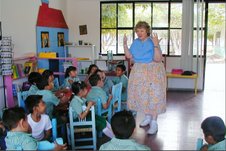
It is a poinsettia TREE! I had never seen a poinsettia tree before. There were quite a few in the Guadalajara area although I have not seen any in PV.
The poinsettia plant is native to Mexico and grows wild. The trees were gorgeous. They are selling many, many poinsettia plants, everywhere in Mexico, for Christmas, just like in the USA but these folks have their own tree in their yard!
As I was taking the picture, the Mexican family who lived there came out of the house, all dressed up, to go somewhere, so we started visiting. I learned they had just moved back to Mexico after living in Chicago for a while! Naturally, we talked a long time---lamenting the fact that we miss Chicago pizza (!), and talking about how beautiful the city is and how much we like Chicago. What a nice surprise! And they gave Rosario a cutting off the tree so she can plant it in her yard.
This is my new boyfriend!! I hope Mr. Neat doesn't get jealous!!
This lady was standing in the door of her shop in downtown Tlaquepaque selling handmade items.
Another option for food! Tortillas on the grill, a big pot of soup or pozole in the back. It all looks good but I must pass up the food being sold at puestos because I am not sure how healthy it would be for me. Food puestos (stalls) are abundant and usually there are people eating at every one of them. It seems to me that the Mexican people eat all the time---but they don't eat much at one time. "Eat little but often" must be their motto!

This photo is very bright and I will have to crop it when I get home, but I want you to see the two women making baskets to sell. The people are constantly making things to sell: weaving baskets, painting ceramics, carving wood, making jewelry. They are very industrious.
Tlaquepaque is a suburb of Guadalajara. (Tla-kay-pah-kay. Isn't that fun to say?) My friend, Rosario, and her family live there. There are 4 major suburbs around Guadalajara that make up the metropolitan area of the city.
Within each city, everywhere in Mexico, there are neighborhoods and each neighborhood, or colonia, has a name which is always used in the address of the home. For example, I live in the "Jardin del Puerto" colonia of Puerto Vallarta.
Guadalajara, the 2nd largest city in Mexico, is the home to several universities, has a wonderful historic area in the downtown, major shopping malls as well as the quaint areas where artisans sell their wares. The weather there is the best! You can get along without air-conditioning in the summer because the temperatures range in the high 70s-80s with a little breeze and low humidity. In the winter, they tell me it is chilly in the mornings and evenings but during the day there are comfortable 70 degree days. For the people living there, wintertime brings out parkas, scarves and mittens but for "us northerners" (ie, anyone living north of Texas!) a light jacket will suffice!
I really enjoy the city of Guadalajara and the people who live there are very hospitable. Planning a vacation to Mexico? I suggest Guadalajara as a number 1 stop on your itinerary!
Hasta luego.



















































